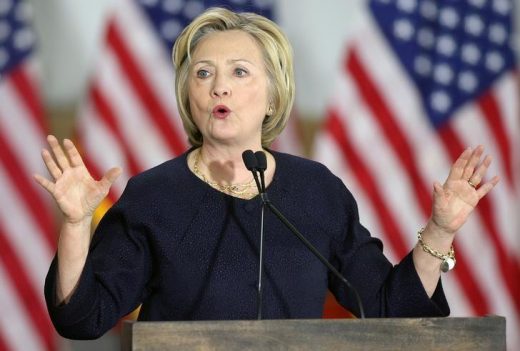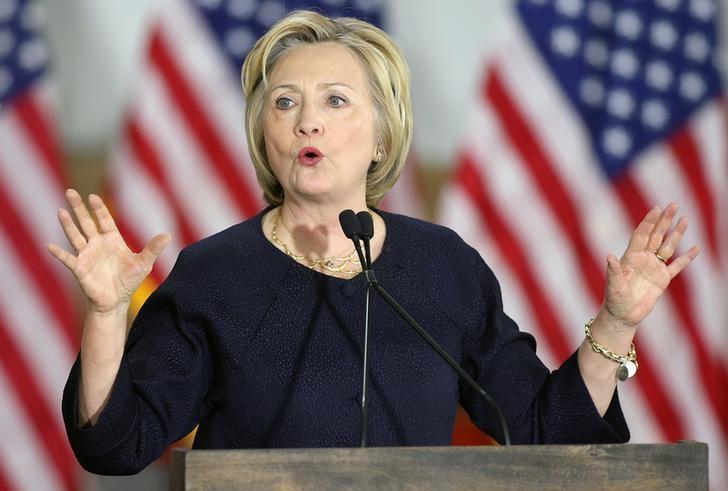Hillary Clinton’s State Dept. Calendar Missing Scores of Entries
Hillary Clinton’s State Dept. Calendar Missing Scores of Entries
(WASHINGTON) — An Associated Press review of the official calendar Hillary Clinton kept as secretary of state identified at least 75 meetings with longtime political donors, Clinton Foundation contributors and corporate and other outside interests that were not recorded or omitted the names of those she met.
The fuller details of those meetings were included in files the State Department turned over to the AP after it sued the government in federal court.
The missing entries raise new questions about how Clinton and her inner circle handled government records documenting her State Department tenure — in this case, why the official chronology of her four-year term does not closely mirror the other, more detailed records of her daily meetings.
At a time when Clinton’s private email system is under scrutiny by an FBI criminal investigation, the calendaromissions reinforce concerns that she sought to eliminate the “risk of the personal being accessible” — as she wrote in an email exchange that she failed to turn over to the government but was subsequently uncovered in a top aide’s inbox.
The AP found the omissions by comparing the 1,500-page calendar with separate planning schedules supplied toClinton by aides in advance of each day’s events. The names of at least 114 outsiders who met with Clinton were missing from her calendar, the records show.
No known federal laws were violated and some omissions could be blamed on Clinton’s highly fluid schedule, which sometimes forced late cancellations. But only seven meetings in Clinton’s planning schedules were replaced by substitute events on her official calendar. More than 60 other events listed in Clinton’s planners were omitted entirely in her calendar, tersely noted or described only as “private meetings” — all without naming those who met with her.
Clinton campaign spokesman Nick Merrill said Thursday night that the multiple discrepancies between her State Department calendar and her planning schedules “simply reflect a more detailed version in one version as compared to another, all maintained by her staff.”
Merrill said that Clinton “has always made an effort to be transparent since entering public life, whether it be the release of over 30 years of tax returns, years of financial disclosure forms, or asking that 55,000 pages of work emails from her time of secretary of state be turned over to the public.”
In one key omission, Clinton’s State Department calendar dropped the identities of a dozen major Wall Street and business leaders who met with her during a private breakfast discussion at the New York Stock Exchange in September 2009, The meeting occurred minutes before Clinton appeared in public at the exchange to ring the market’s ceremonial opening bell.
Despite the omission, Clinton’s State Department planning schedules from the same day listed the names of allClinton’s breakfast guests — most of whose firms had lobbied the government and donated to her family’s global charity. The event was closed to the press and merited only a brief mention in her calendar, which omitted all her guests’ names — among them Blackstone Group Chairman Steven Schwarzman, PepsiCo CEO Indra Nooyi and then-New York Bank of Mellon CEO Robert Kelly.
Clinton’s calendar also repeatedly omitted private dinners and meetings with political donors, policy sessions with groups of corporate leaders and “drop-bys” with old Clinton campaign hands and advisers. Among those whose names were omitted from her calendar were longtime adviser Sidney Blumenthal, consultant and former ClintonWhite House chief of staff Thomas “Mack” McLarty, former energy lobbyist Joseph Wilson and entertainment magnate and Clinton campaign bundler Haim Saban.
The AP first sought Clinton’s calendar and schedules from the State Department in August 2013, but the agency would not acknowledge even that it had the material. After nearly two years of delay, the AP sued the State Department in March 2015. The department agreed in a court filing last August to turn over Clinton’s calendar, and provided the documents in November. After noticing discrepancies between Clinton’s calendar and some schedules, the AP pressed in court for all of Clinton’s planning material. The U.S. has released about one-third of those planners to the AP, so far.
The State Department censored both sets of documents for national security and other reasons, but those changes were made after the documents were turned over to the State Department at the end of Clinton’stenure.
The documents obtained by the AP do not show who specifically logged entries in Clinton’s calendar or who edited the material. Clinton’s emails and other records show that she and two close aides, deputy chief of staff Huma Abedin and scheduling assistant Lona J. Valmoro, held weekly meetings and emailed almost every day aboutClinton’s plans. According to the recent inspector general’s audit and a court declaration made last December by the State Department’s acting executive secretary, Clinton’s aides had access to her calendar through a government Microsoft Outlook account. Both Abedin and Valmoro were political appointees at the State Department and are now aides in her presidential campaign.
Unlike Clinton’s planning schedules, which were sent to Clinton each morning, her calendar was edited after each event, the AP’s review showed. Some calendar entries were accompanied by Valmoro emails — indicating she may have added those entries. Every meeting entry also included both the planned time of the event and the actual time — showing that Clinton’s calendar was being used to document each meeting after it ended.
The State Department said Friday that “extensive records” from Clinton’s calendars were preserved. Spokesman John Kirby said he couldn’t speak in more detail about practices during Clinton’s tenure because of the AP’s ongoing lawsuit.
Kirby said the department was confident it was properly preserving Secretary John Kerry’s calendars and other historic documents, but he noted that Kerry was not required to include details of private, non-work-related meetings. Kirby declined to specify the agency’s definition of those private sessions, saying only that “there are obviously some moments of his life that have no bearing on his work as secretary of state.”
Kirby would not comment on how Clinton and other former secretaries handled their calendars. Five former State Department logistics officials told the AP that some of Clinton’s predecessors also omitted some private meetings from their calendars. The former officials, who spoke on condition of anonymity because they were not authorized to publicly discuss sensitive agency practices, said omitted meetings typically were for medical or other personal reasons as opposed to the meetings Clinton attended with political and charity donors and with corporate executives.
P.J. Crowley, a State Department spokesman for Clinton at the time, told the AP that Clinton’s vision of “21st century statecraft” included exchanging views with corporate leaders and promoting public-private partnerships. “That was certainly reflected in her day-to-day schedule, her travel and her global outreach,” Crowley said.
The former department officials as well as government records experts said that secretaries of state have wide latitude in keeping their schedules — despite federal laws and agency rules overseeing the archiving of calendarsand warning against altering or deleting records. Omissions in Clinton’s calendar could undermine the document’s historical accuracy, particularly its depictions of Clinton’s access to political, corporate and other influences, experts said.
“It’s clear that any outside influence needs to be clearly identified in some way to at least guarantee transparency. That didn’t happen,” said Danielle Brian, executive director of the Project on Government Oversight, a nonpartisan government reform group. “These discrepancies are striking because of her possible interest at the time in running for the presidency.”
Clinton’s terse calendar entry on her 2009 private breakfast on Wall Street contains no details on what she and her 12 guests discussed.
Besides Schwarzman, Nooyi and Kelly, Clinton’s other guests were Fabrizio Freda, CEO of the Estee Lauder Companies Inc.; Howard Schultz, CEO of Starbucks Corp.; Lewis Frankfort, chairman of Coach Inc.; Ellen Kullman, then-CEO of DuPont; David M. Cote, CEO of Honeywell International Inc.; James Tisch, president of Loews Corp.; John D. Wren, CEO of Omnicom Group; then-McGraw Hill Companies chairman Harold McGraw III; and James Taiclet, chairman of the American Tower Corp. Also attending was then-NYSE CEO Duncan Niederauer, who later accompanied Clinton when she rang the stock exchange bell.
Four of the attendees — Schwarzman, Nooyi, Cote and Kullman — headed companies that later donated to Clinton’s pet diplomatic project of that period, the U.S. pavilion at the 2010 Shanghai Expo.
All the firms represented except Coach lobbied the government in 2009; Blackstone, Honeywell, Omnicom and DuPont lobbied the State Department that year. Schwarzman and Frankfort have personally donated to theClinton Foundation, and the other firms — except for American Tower and New York Bank of Mellon — also contributed to the Clinton charity.
__
Associated Press writer Bradley Klapper contributed to this report.
(41)



